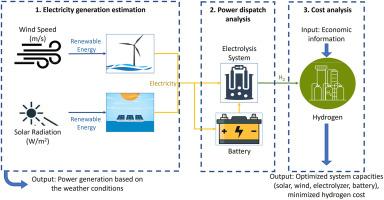海上风能-太阳能一体化系统绿色制氢技术经济分析
IF 8.3
2区 工程技术
Q1 CHEMISTRY, PHYSICAL
引用次数: 0
摘要
利用可再生能源电解水而产生的“绿色”氢有望在未来成为一种多功能的能源载体。本研究考察了日本千叶县长志地区联合海上风能-太阳能制氢系统的技术经济性能,这是一个平均风速高的地区。利用每小时风速和太阳辐射数据模拟了两种系统配置下的制氢情况:无电池的无限断电和有电池储能的不断电。在不断电的情况下,电池集成在2025年、2030年和2050年分别使名义氢成本增加了43.8%、17.7%和19.8%。然而,考虑到电解槽因退化而导致的更高OPEX的敏感性分析表明,无限断电系统可能会变得更加昂贵,从长远来看,电池支持系统在经济上是有利的。这些发现强调了集成电池存储以提高海上风能-太阳能制氢系统的技术可靠性和经济途径的重要性。本文章由计算机程序翻译,如有差异,请以英文原文为准。

Techno-economic analysis of integrated offshore wind–solar energy systems for green hydrogen production
‘Green’ hydrogen, produced by the electrolysis of water using renewable energy sources, is expected to become a versatile energy carrier in the future. This study examined the techno-economic performance of combined offshore wind-solar energy systems for hydrogen production in Choshi, Chiba Prefecture, Japan, a region with high average wind speeds. Hourly wind speed and solar radiation data were used to simulate hydrogen production under two system configurations: unlimited power cuts without batteries and no power cuts with battery storage. In the no-power-cut case, battery integration increased the nominal hydrogen cost by 43.8 %, 17.7 %, and 19.8 % in 2025, 2030, and 2050, respectively. However, sensitivity analysis considering higher electrolyzer OPEX due to degradation revealed that the unlimited power-cut system can become more expensive, making battery-supported systems economically favorable over the long term. These findings highlight the importance of integrating battery storage to enhance technical reliability and economical pathways for offshore wind–solar hydrogen production systems.
求助全文
通过发布文献求助,成功后即可免费获取论文全文。
去求助
来源期刊

International Journal of Hydrogen Energy
工程技术-环境科学
CiteScore
13.50
自引率
25.00%
发文量
3502
审稿时长
60 days
期刊介绍:
The objective of the International Journal of Hydrogen Energy is to facilitate the exchange of new ideas, technological advancements, and research findings in the field of Hydrogen Energy among scientists and engineers worldwide. This journal showcases original research, both analytical and experimental, covering various aspects of Hydrogen Energy. These include production, storage, transmission, utilization, enabling technologies, environmental impact, economic considerations, and global perspectives on hydrogen and its carriers such as NH3, CH4, alcohols, etc.
The utilization aspect encompasses various methods such as thermochemical (combustion), photochemical, electrochemical (fuel cells), and nuclear conversion of hydrogen, hydrogen isotopes, and hydrogen carriers into thermal, mechanical, and electrical energies. The applications of these energies can be found in transportation (including aerospace), industrial, commercial, and residential sectors.
 求助内容:
求助内容: 应助结果提醒方式:
应助结果提醒方式:


